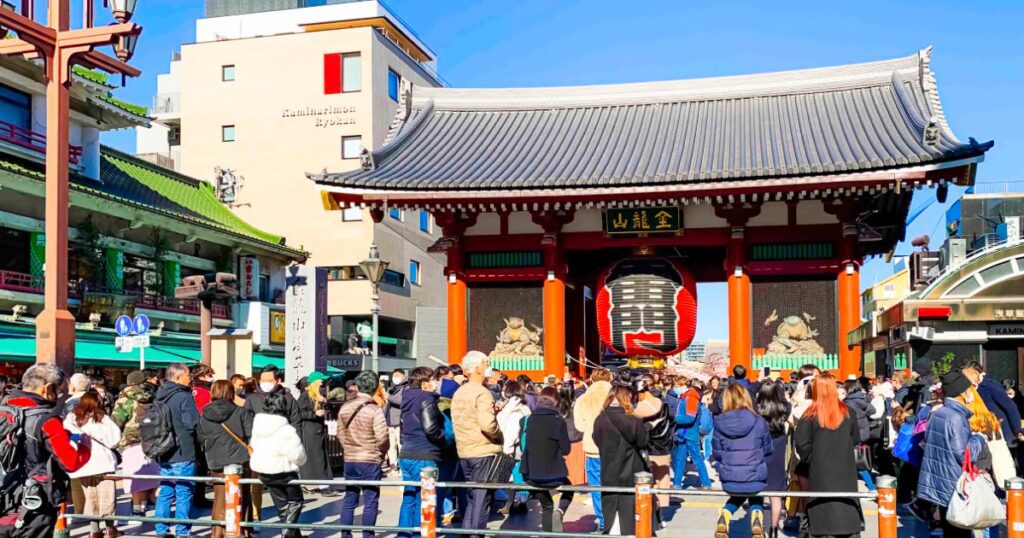As you roam the lively streets of Tokyo, Japan, navigating through the sea of neon lights and modern architecture, there’s a place where time seems to stand still. That place is Asakusa, and its heart beats from the iconic Kaminarimon Gate, an enduring symbol of Tokyo’s rich cultural heritage.
Situated in Asakusa, Taito City, the Kaminarimon Gate, or “Thunder Gate,” marks the outer entrance to the famous Senso-ji temple. The gate serves as the threshold to Nakamise-dori, a bustling shopping street that echoes the city’s vibrancy and the Edo era’s timeless spirit.
Table of Contents
History of Kaminarimon:
Constructed in 941, the Kaminarimon Gate has stood the test of time, albeit not without challenges. The gate has witnessed the ebb and flow of history, surviving fires, and repeated reconstructions. Although the original entrance is long gone, its spirit lives on in its latest incarnation, rebuilt in 1960.
A Portal to the Divine:
As you approach the Kaminarimon Gate, the first thing that catches your eye is the striking, oversized red paper lantern or ‘chochin’. Weighing in at roughly 700 kilograms and spanning a circumference of 3.4 meters, it is an awe-inspiring sight. The inscriptions on the lantern read ‘Kaminarimon’ at the front and ‘Matsushita Denki,’ the name of the company that donated the lantern, on the back.
Four statues stand on either side of the gate, protected by the massive structure. These statues are depictions of Fujin and Raijin on the front, the Shinto gods of wind and thunder, respectively, and Tenryu and Kinryu on the back, two significant Buddhist figures. These statues serve as a fusion of Shinto and Buddhist beliefs, symbolizing the syncretic religious culture of Japan.
Kaminarimon Gate Today:
Today, the Kaminarimon Gate continues to be an important cultural symbol of Tokyo. This bustling tourist hotspot brims with people eager to capture the perfect shot of the gate or purchase a souvenir from the adjacent Nakamise shopping street. Despite the modern hustle and bustle that surrounds it, the gate remains a serene beacon of history and spirituality.
The Kaminarimon Gate also plays a significant role during the annual Sanja Matsuri festival, one of Tokyo’s most significant and lively festivals, making it a must-visit during May.
Stepping into the Future:
While the Kaminarimon Gate is firmly rooted in Tokyo’s history, it continues to inspire and inform the city’s future. As we step through the gate, we are reminded of Tokyo’s resilience and its ability to honor its past while innovating for the future, much like the gate itself, which has weathered centuries of change.
Stepping through the Kaminarimon Gate is more than just a journey into a temple; it’s a journey through time, a testament to Tokyo’s vibrant history, and a nod to its bright future.
So, the next time you’re in Tokyo, remember to visit the Kaminarimon Gate, a historic gem nestled in the heart of modern Tokyo.
Opening hours: 24 hours (every day)
Admission: Free
Note: As for the opening hours, the Kaminarimon Gate is technically open 24 hours a day, seven days a week, as it is an outdoor structure.
However, the shopping street (Nakamise-dori) that leads from the gate to the Senso-ji Temple is usually open from around 9:00 AM to 7:00 PM. Still, the timing can vary depending on the individual shop.
The main hall of Senso-ji Temple itself is also open 24/7, but its offering hall is typically open from 6:00 AM to 5:00 PM (timing may vary slightly depending on the season).
How to access it?
By Train: The easiest way to reach Kaminarimon Gate is by train. The closest station is Asakusa Station, which is serviced by the Ginza Subway Line, Asakusa Subway Line, and Tobu Railways. From Asakusa Station, it’s only a short walk to the gate.
By Bus: Various city buses stop in Asakusa nearby Kaminarinmon Gate, from where the Kaminarimon Gate is a short walk away.
By Boat: If you’re looking for a more scenic route, you can also take a water bus (river ferry) to Asakusa. The Tokyo Water Bus offers services that stop at Asakusa Pier, which is a 10-minute walk from the gate. Visitors can access direct from in front of the Statue of Liberty in Odaiba.
Once you arrive in Asakusa, you should easily find signs or local maps guiding you to Kaminarimon Gate and the adjoining Senso-ji temple.
Address:
2 Chome-3-1 Asakusa, Taito City, Tokyo 111-0032, Japan
Keywords:
Kaminarimon Gate, Asakusa, Tokyo, Japan, Senso-ji Temple, Nakamise shopping street, Fujin, Raijin, Tenryu, Kinryu, history, culture, travel, Shinto, Buddhism, Sanja Matsuri festival, Japanese history.
